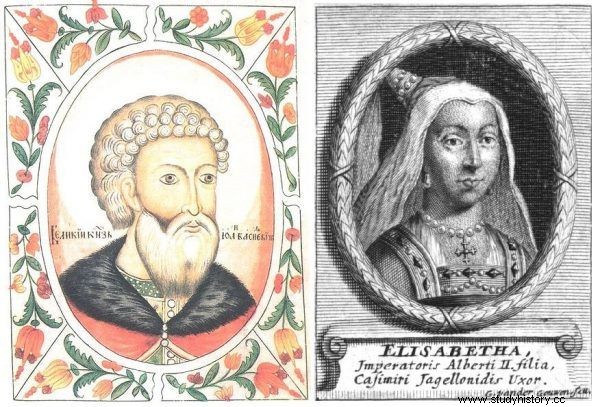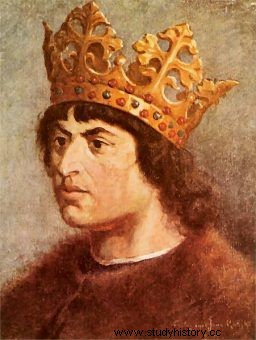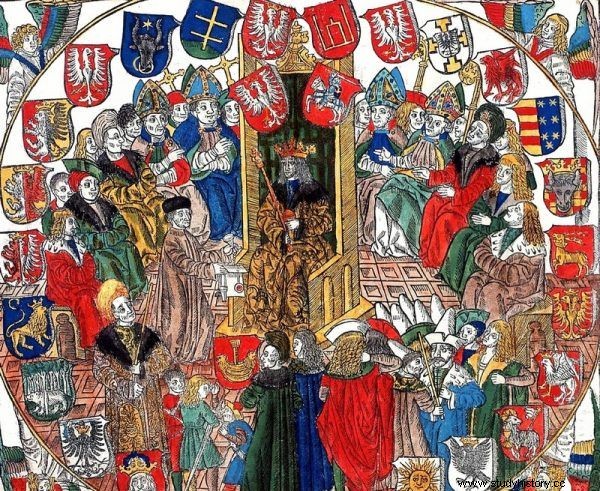Poland and Moscow have never been able to get along. Tried with a sword and a good word, but to no avail. Finally, heavy matrimonial guns were launched. With a view to establishing lasting peace, Jagiełło's grandson was bonded with the daughter of Ivan III Srogy. A quite successful group emerged from the political arrangements, although each tried to make the lives of the newlyweds difficult ...
Helena Rurykowiczówna was born in 1474. Her mother, Zofia, came from the last dynasty ruling the Byzantine Empire - the Palaeologists, and was adopted by the Pope. Probably, Helena, like her mother, received a thorough education at the Moscow court. She also loved music.
The young princess quickly became the target of political bargaining. It was getting hot around the Jagiellonian house when the Habsburgs tried to win over Helena's hand. Their intrigues were to lead to a Habsburg-Moscow alliance against Poland.
If this happened, Korona and Lithuania would be in quite a trouble and would inevitably be attacked from both sides. Therefore, as early as 1484, efforts were made to marry the princess with the Polish-Lithuanian prince (or prince), Aleksander Jagiellończyk.

Neither Aleksander was lightly with his father-in-law (left), nor Helena with his mother-in-law (right). Because who saw it to invade the lands of his son-in-law by force and force the daughter-in-law to change her religion?
Confessional bone of contention
It was only in 1495 that Ivan agreed to his daughter's marriage, but only on the condition that she would stick to her religion (Orthodoxy). Alexander - then already sitting on the throne of the Grand Duchy of Lithuania - agreed to this and even signed a special act guaranteeing his wife freedom of religion, in which he refrained from any attempts to persuade her to convert to Catholicism.
The mother-in-law showed much less tolerance at the outset Helena, Elżbieta Rakuszanka. The old queen immediately began to persuade her daughter-in-law to convert. Despite her age, she even went to Lithuania for this purpose.
She didn't do much, because Helena stubbornly stood by her faith. Equally emphatic was Pope Alexander VI, who even demanded that Alexander's wife change her religion. He threatened to consider her a schismatic and demanded that the Jagiellonian speak reasonably to the woman. Fortunately for the ruler, another pope - Julius II - under the influence of Erazm Ciołek, resigned from the position of his predecessor.
The Trojan Horse, or Helena of Moscow?
When Helena came to Vilnius on February 15, 1495, she was accompanied, as befits a prince's daughter, by a great and very numerous retinue. A wedding took place shortly after, for which the Jagiellonian obtained the special consent of the Pope.
The liturgy was celebrated in the Latin rite, but Orthodox clergy smuggled some of their own accents into it. In this case, there were no conflicts. But Alexander was adamant about his wife's entourage from Moscow.

Fearing the members of the Moscow retinue of espionage activity on behalf of Ivan III, he sent everyone home. Instead, the princess was surrounded by Poles, Lithuanians and Ruthenians. In fact, the suspicions of espionage were correct, because that was what the father of the bride expected.
Ivan tried at all costs to make Helena his agent at the court of his son-in-law . Much to her father's displeasure, the princess was increasingly reluctant to do so. She slowly entered the roles of wife and Grand Duchess of Lithuania and began to identify with them.
Interestingly, Helena had an incredible amount of tact and political sense. As a result, she remained loyal to both her father and her husband, and relieved tensions between Moscow and Vilnius as much as possible. In 1502, she put a lot of effort into seeking peace with Ivan III.
This article has more than one page. Please select another one below to continue reading.Attention! You are not on the first page of the article. If you want to read from the beginning click here.

Aleksander Jagiellończyk. Not only had history basically forgotten him, but everyone else was trying to break up his marriage ...
A few drops of bitterness in a Trójniak cup
The beginning of the 16th century was not favorable to interfaith marriages. Rather, one spouse was expected to convert to the other's confession. It was similar with the Polish royal couple Alexander and Helena, the only daughter of the Moscow ruler, who married the Polish monarch .
After the coronation (from 1492 Alexander was the Grand Duke of Lithuania, from 1501 he also reigned in Poland), the king complained about the enormous disrespect on the part of the Polish clergy. He could not understand why his beloved wife had been refused to be crowned with him. In December 1501, when the crown was placed on Alexander's temple, Helena was still stubbornly adhering to Orthodoxy, which Polish dignitaries could not swallow.
The Queen was introduced to Wawel on February 4, 1502. As Urszula Borkowska, author of the book "The Jagiellonian Dynasty in Poland" writes, Helena in the Crown did not feel well.
Her innovativeness was clearly visible here and widely condemned (the public was irritated especially by the Orthodox services celebrated in the Wawel Cathedral), but her husband found support . As far as possible, Alexander protected her from unpleasantness, and despite his Catholic devotion, he did not press her to change her religion.

Aleksander in Rzeczpospolita had to deal with the opposition of the powerful against his wife ... King Alexander in the Senate (painting by Jan Haller, public domain).
It was not easy for a happy marriage to be reasonable
Based on the preserved sources, we can assume that the marriage of Alexander and Helena was a happy one. However, many things overshadowed their situation.
One of the most important was probably the conduct of Ivan III. Helena was supposed to bring peace as a dowry, and probably nothing else (in her letters to her father she praises her husband for accepting her without the proper dowry). Ivan III did little of it and instead of keeping the terms of the agreement ... he invaded the lands on the Lithuanian-Moscow border.
The Orthodox queen was never fully accepted by the Catholic nobility of Lithuania and the Crown, although her co-religionists welcomed her with open arms as a harbinger of an improvement in their fate. In fact, Helena obtained from her husband certain privileges for the Orthodox clergy and the population.

The royal couple also experienced a personal tragedy. Despite their feelings between Aleksander and Helena, they did not have children . In the ruling family, this is a double misfortune, because the lack of children is equivalent to the inability to pass the legacy to an heir.
Because when you don't know what's going on, it's always about money!
Another tragedy was - of course - the premature death of Aleksander Jagiellończyk, who left the earthly valley only eleven years after the wedding. The fate of the widow queen was then influenced by a prosaic thing:money.
By being married to the Polish king, Helena accumulated a huge fortune which she deposited with the Vilnius Bernardines. Fourteen chests were estimated to contain a staggering sum of 400,000 florins. Lithuanian gentlemen at all costs tried to keep Helena, or rather her fortune, in Lithuania.
In 1513 the queen widow was reportedly poisoned by Mikołaj Radziwiłł, and her property mysteriously disappeared ...
Source:
- Urszula Borkowska, The Jagiellonian Dynasty in Poland , Polish Scientific Publishers PWN, Warsaw 2011.
